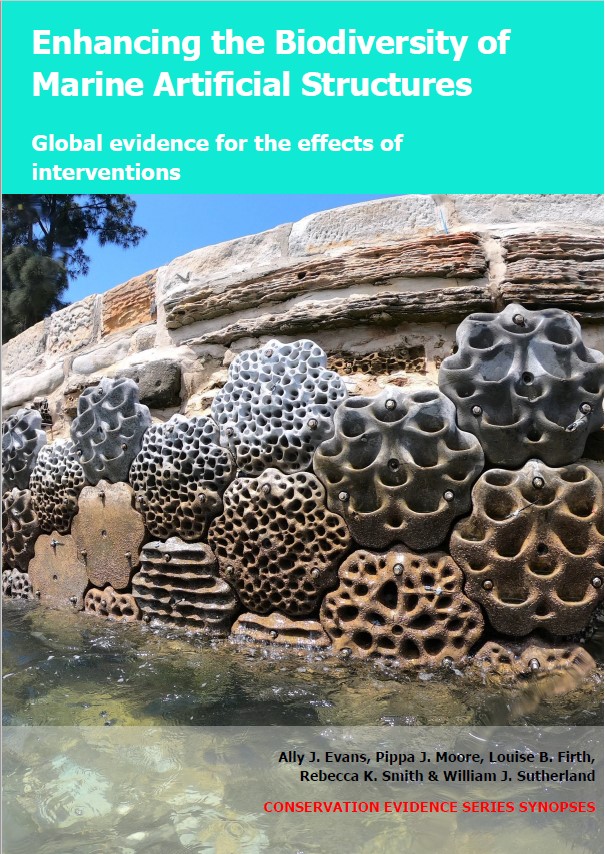Create textured surfaces (≤1 mm) on subtidal artificial structures
-
Overall effectiveness category Awaiting assessment
-
Number of studies: 3
View assessment score
Hide assessment score
How is the evidence assessed?
-
Effectiveness
not assessed -
Certainty
not assessed -
Harms
not assessed
Study locations
Supporting evidence from individual studies
A replicated, randomized, controlled study in 2005 on three subtidal rocky reefs on open coastlines in the Adriatic Sea and the Ionian Sea, Italy (Guarnieri et al. 2009) found that settlement plates with and without textured surfaces supported similar macroalgae and non-mobile invertebrate species richness, live cover and community composition, while abundances varied depending on the species group and site. After nine months, there was no clear difference in the macroalgae and non-mobile invertebrate community composition, species richness or live cover on plates with and without textured surfaces (data reported as statistical model results). Non-mobile invertebrates were more abundant on plates with texture (<1–6% cover) than without (<1–2%) but the difference was only significant at one of six sites. Macroalgal abundances varied by species group and site (see paper for results). Limestone, sandstone, granite and concrete settlement plates (150 × 100 mm) were made with and without textured surfaces. Five of each material-texture combination were randomly arranged, horizontally at 5 m depth in each of two sites on each of three limestone rocky reefs in February 2005. Macroalgae and non-mobile invertebrates on plates were counted in the laboratory over nine months.
Study and other actions testedA replicated, randomized, controlled study (year not reported) on open coastlines in the Mediterranean Sea and the Gulf of Aqaba, Israel (Perkol-Finkel & Sella 2014) found that upward-facing settlement plates with textured surfaces supported similar macroalgae and non-mobile invertebrate abundance but different community composition to downward-facing surfaces without texture. After 12 months, macroalgae and non-mobile invertebrate live cover was similar on upward-facing settlement plate surfaces with texture (81–100%) and downward-facing surfaces without (80–100%), but the community composition differed (data reported as statistical model results). Concrete settlement plates (150 × 150 mm) were moulded with textured surfaces on one side and flat on the other, using a formliner. Plates were either standard-concrete or one of five patented ECOncreteTM materials. Ten of each material were randomly arranged horizontally with textured surfaces facing upwards on frames at 6 m depth in the Mediterranean Sea and at 10 m in the Gulf of Aqaba (month/year not reported). Macroalgae and non-mobile invertebrates on plates were counted and biomass (dry weight) was recorded in the laboratory over 12 months.
Study and other actions testedA replicated, controlled study in 2013–2014 on 24 jetty pilings in the Hudson River estuary, USA (Perkol-Finkel & Sella 2016) found that creating textured surfaces on the pilings, along with using environmentally-sensitive material, increased the macroalgae and invertebrate species richness, cover and biomass and altered the community composition on piling surfaces. After 14 months, pilings with textured surfaces and environmentally-sensitive material supported 18 macroalgae and invertebrate species with 90–100% cover, while fibreglass pilings without texture supported nine species with 40–85% cover (data not statistically tested). Biomass was higher on pilings with textured surfaces (0.07 g/cm2) than without (0.02 g/cm2) and the community composition differed (data reported as statistical model results). Over 14 months, six species (4 non-mobile invertebrates, 2 mobile invertebrates) recorded on pilings with texture were absent from those without. It is not clear whether these effects were the direct result of creating textured surfaces or using environmentally-sensitive material. Textured surfaces were created on concrete jetty piling encasements using a formliner during maintenance works. Nine textured encasements made from patented ECOncreteTM material and three untextured fibreglass encasements were attached around pilings in each of two sites along a jetty in June 2013 (depth not reported). Macroalgae and invertebrates were counted on and around pilings and biomass was measured (dry weight) in the laboratory over 14 months.
Study and other actions tested
Where has this evidence come from?
List of journals searched by synopsis
All the journals searched for all synopses
This Action forms part of the Action Synopsis:
Biodiversity of Marine Artificial Structures
Biodiversity of Marine Artificial Structures - Published 2021
Enhancing biodiversity of marine artificial structures synopsis





)_2023.JPG)














